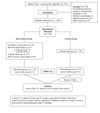The impact of a video intervention on the use of low vision assistive devices
- PMID: 17435527
- PMCID: PMC1858638
- DOI: 10.1097/OPX.0b013e3180339a03
The impact of a video intervention on the use of low vision assistive devices
Abstract
Purpose: An image-enhanced educational and motivational video was developed for patients with low vision and their caretakers. Impact on knowledge, self-efficacy, and attitudes was assessed.
Methods: The video incorporated cognitive restructuring to change emotional response; a "virtual home"; a veridical simulation of vision with age-related macular degeneration and contrast enhancement of the video. Subjects (median age 77.5) were randomized into control (n=79) and intervention (n=75) groups. Telephone interviews were at baseline, 2 weeks and 3 months. Main outcome measures were: knowledge (eight questions), self-efficacy score (seven questions), adaptive behaviors (10 questions), willingness to use devices, and emotional response (4-point scales).
Results: The intervention group showed a statistically significant improvement in knowledge, (difference of 1.1 out of eight questions, p<0.001). Change in use of books-on-tape was more for the intervention group than for controls (p=0.005). The intervention group increased use of books-on-tape from 28 to 51% whereas the control group did not (34% at both times). However, there was no significant change in the use of other assistive devices, including magnifiers. Both groups increased adaptive behaviors. There was no significant difference in change of self-efficacy score or in emotional affect between the two groups.
Conclusions: The video had a small, but statistically significant impact on knowledge and willingness to use assistive devices. There was little impact on adaptive behaviors and emotional affect. The minimal changes in outcome were disappointing, but this does not minimize the importance of patient education; it just emphasizes how hard it is to effect change.
Figures









Comment in
-
An educational and motivational video improved knowledge and willingness to use books-on-tape in people with low vision but did not improve self-efficacy, emotional response or adaptive behaviours.Aust Occup Ther J. 2008 Sep;55(3):216-7. doi: 10.1111/j.1440-1630.2008.768_2.x. Aust Occup Ther J. 2008. PMID: 20887466 No abstract available.
Similar articles
-
Reading performance with low-vision aids and vision-related quality of life after macular translocation surgery in patients with age-related macular degeneration.Acta Ophthalmol Scand. 2007 Dec;85(8):877-82. doi: 10.1111/j.1600-0420.2007.00963.x. Epub 2007 Jul 25. Acta Ophthalmol Scand. 2007. PMID: 17651462
-
Outcomes of the Veterans Affairs Low Vision Intervention Trial (LOVIT).Arch Ophthalmol. 2008 May;126(5):608-17. doi: 10.1001/archopht.126.5.608. Arch Ophthalmol. 2008. PMID: 18474769 Clinical Trial.
-
Impact of a low-vision self-management program on informal caregivers.Optom Vis Sci. 2011 Dec;88(12):1486-95. doi: 10.1097/OPX.0b013e318230ed46. Optom Vis Sci. 2011. PMID: 21926651 Clinical Trial.
-
Survey of optometric low vision rehabilitation training methods for the moderately visually impaired.Optometry. 2009 Apr;80(4):185-92. doi: 10.1016/j.optm.2008.10.015. Optometry. 2009. PMID: 19329062 Review.
-
Age-related eye diseases and recommendations for low-vision AIDS.Home Healthc Now. 2015 Jan;33(1):10-7; quiz 18-9. doi: 10.1097/NHH.0000000000000177. Home Healthc Now. 2015. PMID: 25654340 Review.
Cited by
-
Self-management interventions for quality of life in adults with visual impairment.Cochrane Database Syst Rev. 2025 Feb 10;2(2):CD015790. doi: 10.1002/14651858.CD015790.pub2. Cochrane Database Syst Rev. 2025. PMID: 39927516
-
Watch this space: a systematic review of the use of video-based media as a patient education tool in ophthalmology.Eye (Lond). 2020 Sep;34(9):1563-1569. doi: 10.1038/s41433-020-0798-z. Epub 2020 Mar 9. Eye (Lond). 2020. PMID: 32152516 Free PMC article.
-
The effect of a video tutorial to improve patients' keratoconus knowledge - a randomized controlled trial and meta-analysis of published reports.Front Ophthalmol (Lausanne). 2022 Oct 24;2:997257. doi: 10.3389/fopht.2022.997257. eCollection 2022. Front Ophthalmol (Lausanne). 2022. PMID: 38983549 Free PMC article.
-
Low vision rehabilitation for better quality of life in visually impaired adults.Cochrane Database Syst Rev. 2020 Jan 27;1(1):CD006543. doi: 10.1002/14651858.CD006543.pub2. Cochrane Database Syst Rev. 2020. PMID: 31985055 Free PMC article.
-
Low vision rehabilitation in improving the quality of life for patients with impaired vision: A systematic review and meta-analysis of 52 randomized clinical trials.Medicine (Baltimore). 2021 May 14;100(19):e25736. doi: 10.1097/MD.0000000000025736. Medicine (Baltimore). 2021. Retraction in: Medicine (Baltimore). 2021 Jul 16;100(28):e26669. doi: 10.1097/MD.0000000000026669. PMID: 34106601 Free PMC article. Retracted.
References
-
- National Eye Health Education Program. Low Vision Public Education Plan [NEI National Eye Health Education Program (NEHEP)] Vol. 2006 National Eye Institute; 1999.
-
- Rahmani B, Tielsch J, Katz J, et al. The Cause-specific Prevalence of Visual Impairment in an Urban Population. Ophthalmology. 1996;103:1721–1726. - PubMed
-
- Friedman DS, O’Colmain BJ, Munoz B, et al. Prevalence of Age-Related Macular Degeneration in the United States. Archives of Ophthalmology. 2004;122:564–572. - PubMed
-
- Congdon N, O’Colmain B, Klaver CCW, et al. Causes and Prevalence of Visual Impairment Among Adults in the United States. Archives of Ophthalmology. 2004;122:477–485. - PubMed
-
- Richer S, Stiles W, Statkute L, et al. Double-masked, placebo-controlled, randomized trial of lutein and antioxidant supplementation in the intervention of atrophic age-related macular degeneration: the Veterans LAST study (Lutein Antioxidant Supplementation Trial) Optometry. 2004;75:216–230. - PubMed
Publication types
MeSH terms
Grants and funding
LinkOut - more resources
Full Text Sources

